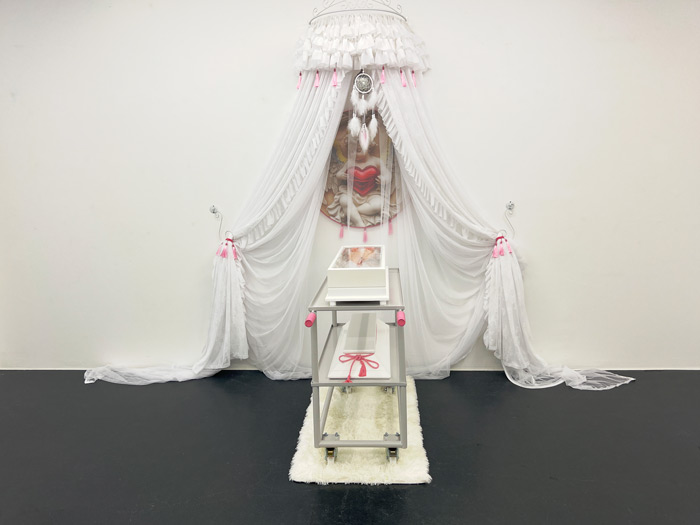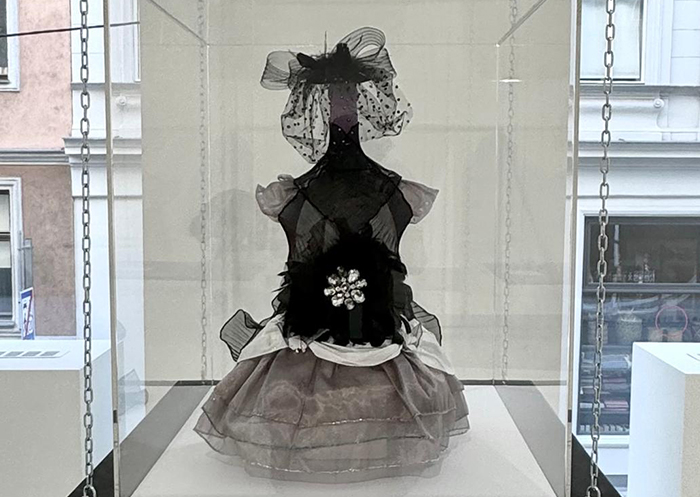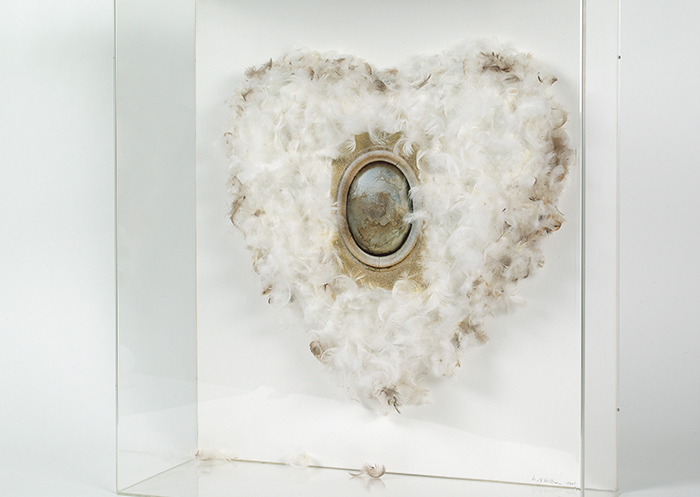
Du sollst Dir ein Bild machen, Künstlerhaus Wien
23.10.2025 - 8.2.2026
https://www.kuenstlerhaus.at/besuch/kalender/ausstellung/475/du-sollst-dir-ein-bild-machen.html
- - -

Im Visier, Galerie Steinek Wien
15.05. - 12.07.2025
https://www.galerie.steinek.at/index.php
Since the mid-1960s, Renate Bertlmann's radical, ironic and provocative works have subverted social attributions and stereotypes surrounding gender and power structures. They address both the female body as contested terrain and the ambivalences of pleasure and pain, desire and vulnerability, omnipotence and resistance.
The exhibition “Im Visier” ("In Sight") brings together works (from 2004 to 2025) that are characterized by a remarkable diversity and combine themes such as suffering or deprivation of liberty with strongly “camp”-like materials. Scenes from crime scenes (such as “Autumn”, 2025), laying-out room or mourning room (such as “Wedding Night”, 2025), self-defence equipment or camouflaged weapons (such as “Messer Rucksack: Le Voyage”, 2025 or “Fuck off”, 2004)... Renate Bertlmann exhibits objects arranged in display cases, as in ethnological museums, and makes use of visual worlds that are considered kitsch and obscene. This exaggerated visual language represents a powerful vector of irony for the artist - it irritates, destabilizes and at the same time opens a door to the absurd and grotesque; an artistic strategy of uncertainty that Bertlmann has always pursued. She targets socio-cultural gender hierarchies and questions what is considered “appropriate” or “acceptable”.
- - -

MOTHER, Galerie Gisela Clement, Bonn
12.02.2025 - 27.03.2025
https://www.galerie-clement.de/exhibitions/renate-bertlmann-und-yasmina-assbane
In their works, Renate Bertlmann and Yasmina Assbane create visual worlds of femininity that take up and alienate heteronormative ideas.
Since the 1970s, Austrian artist Renate Bertlmann (*1943 in Vienna, lives and works there) has created a multifaceted oeuvre. Her drawings, photographs, installations, sculptures and performances stem from the feminist rebellion of a generation of women and artists and transcend boundaries. For the first time, female artists of this period formulated counter-proposals to the prevailing images of women in art and society.
Her performance “Die schwangere Braut im Rollstuhl” (1978, documented photographically by Margot Pilz) deals critically with questions of heteronomy and self-determination of women in marriage and through pregnancy. Bertlmann's visual language is always transgressive and characterized by the simultaneity of opposites.
Yasmina Assbane (*1968 in Belgium, lives and works in Brussels) uses found ceramic, porcelain and glass tableware from rooms read as female for her objects. In combination with nylon tights, she transforms the objects into female bodies and sexual organs, thereby exposing a heteronormativity that is deeply inscribed in our society.
As part of MOTHER, Renate Bertlmann and Yasmina Assbane will be exhibiting together for the first time.
With thanks to Galerie Steinek, Vienna.
- - -

CRUISING IN THE PARK, PARK / parkingspace, Wien
14 November 2024 – 30 Februar 2025
https://www.instagram.com/park_wien/
- - -

The Traumatic Surreal, Henry Moore Institute, Leeds
22 November 2024 – 16 March 2025
https://henry-moore.org/whats-on/the-traumatic-surreal/
Marking the centenary of Surrealism, The Traumatic Surreal explores the appropriation and development of surrealist sculptural traditions by women artists in German-speaking countries after World War II.
The exhibition brings together sculptures and films made between 1964 and 2017 that explore women’s experiences in this context, using surrealist traditions to critique and subvert patriarchal constructions of women as ‘objects’.
Repeated motifs such as cages, an insistent concern with animal characteristics such as fur and feathers, and a questioning of the conventional association between women and domesticity indicate how women surrealists critiqued these restrictive and oppressive conditions.
The Traumatic Surreal addresses the complex legacy of geographically specific historical events that have impacted in powerful and long-lasting ways on women’s experience. In German-speaking countries the period following World War II was – and still is – deeply scarred by the events of the war and the fascist and Nazi ideologies that caused them, particularly in relation to the social construction, positioning and objectification of women.
The exhibition shows how surrealist traditions continue to provide these artists with productive forms through which these, and other, traumatic residues might be represented and negotiated. Embracing the capacity of surrealist art to shock or challenge, these artists show the continuing relevance of Surrealism’s disruptive potential.
The Traumatic Surreal is co-curated with Patricia Allmer, Professor of Modern and Contemporary Art History at the University of Edinburgh, and is based on her book of the same name, published by Manchester University Press, 2024.
Renate Bertlmann (b.1943, Vienna, Austria)
Birgit Jürgenssen (b.1944, Vienna, Austria d.2003, Vienna, Austria)
Bady Minck (b.1962, Ettelbruck, Luxembourg)
Meret Oppenheim (b.1913 Berlin, Germany; d.1985, Basel, Switzerland)
Pipilotti Rist (b.1962, Grabs, Switzerland)
Ursula (Schultze-Bluhm) (b.1921, Brandenburg, Germany; d.1999, Cologne, Germany)
Eva Wipf (b.1929, Santo Angelo do Paraiso, Brazil; d.1978, Brugg, Switzerland)
- - -

Horror Patriae - Steirischer Herbst, Neue Galerie Graz
20.9.24–16.2.25
https://www.steirischerherbst.at/de/program/6263/horror-patriae
- - -

DIE „FREIE ZEIT“, Kunstraum Innsbruck
08.06.24 – 14.08.24
https://www.kunstraum-innsbruck.at/programm/free-time-die-freie-zeit
- - -

20 Jahre SAMMLUNG VERBUND, Albertina, Wien
29.02. - 05.05.2024
https://www.albertina.at/ausstellungen/20-jahre-sammlung-verbund/
The ALBERTINA Museum presents an exhibition of works from VERBUND COLLECTION, Vienna, held in celebration of the collection’s twentieth anniversary. The corporate collection was founded by the leading Austrian electricity company VERBUND in 2004 and holds around one thousand works by two hundred artists. The catalogues released by its publishing arm have given a significant boost to some of the artists’ careers. The show includes new acquisitions that will be presented in Austria for the first time.
The large bodies of work by artists such as Cindy Sherman, Francesca Woodman, Birgit Jürgenssen, and Renate Bertlmann compiled in keeping with VERBUND COLLECTION’s maxim “depth instead of breadth” make up the first part of the exhibition. Sherman is presented side by side with contemporaries like Martha Wilson and younger artists like Aneta Grzeszykowska, who reenacted Sherman’s famous black-and-white series Untitled Film Stills in color. They are followed by works of the feminist avant-garde of the 1970s that deal with the reduction of women to the roles of housewife, wife, and mother, the use of the female body, and female sexuality.
The term feminist avant-garde was coined by VERBUND COLLECTION’s founding director Gabriele Schor in 2007 to honor the pioneering work of these artists. She successfully positioned them in the art-historical canon with an exhibition that toured throughout Europe for ten years. Through this focus on in-depth collecting, Schor secured VERBUND COLLECTION’s singular status.
Works from following artists will be on display:
Renate Bertlmann, Barbara Bloom, Marcella Campagnano, Veronika Dreier, Renate Eisenegger, VALIE EXPORT, Gerda Fassel, Simon Fujiwara, Simryn Gill, Nan Goldin, Aneta Grzeszykowska, Suzy Lake, Lebohang Kganye, Anne Marie Jehle, Birgit Jürgenssen, Kirsten Justessen, Sin Wai Kin, Joachim Koester, Auguste Kronheim, Brigitte Lang, Louise Lawler, Angelika Loderer, Karin Mack, Gordon Matta-Clark, Anita Münz, Zanele Muholi, Ernesto Neto, ORLAN, Gabriel Orozco, Frida Orupabo, Florentina Pakosta, Margot Pilz, Ingeborg G Pluhar, Elodie Pong, Ulrike Rosenbach, Tomoko Sawada, Senga Nengudi, Elaine Shemilt, Cindy Sherman, Lorna Simpson, Penny Slinger, Annegret Soltau, Sophie Thun, Alexander Ugay, Jeff Wall, Gillian Wearing, Carrie Mae Weems, Hannah Wilke, Martha Wilson, David Wojnarowicz, Francesca Woodman, Nil Yalter.
Curator: Gabriele Schor, founding director, VERBUND COLLECTION, Vienna.
- - -

Sterblich sein, Dom Museum, Wien
06.10.2023 – 25.08.2024
https://dommuseum.at/sterblich-information
The exhibition deals with the most inevitable part of every existence. Juxtaposing works of art that span a cultural-historical arc from the Middle Ages to the present, "Being Mortal" traces the deep meaning of death in individual as well as collective and socio-political contexts. The show focuses on intimate, personal approaches as well as the public, political role of dying and the process of facing death.
The extensive graphic works from the legendary Otto Mauer Collection that are also on display, present an opportunity for exciting insights into the collecting activities of this key figure of the Austrian art scene of the postwar period.
The exhibition includes work by Kurt Absolon, Khaled Barakeh, Max Beckmann, Renate Bertlmann, Margret Bilger, Nomin Bold, Jan Brueghel the Younger, Günter Brus, Maria Bussmann, Lovis Corinth, Ramesch Daha, Stefano della Bella, Alexandre Diop, Otto Dix, Albin Egger-Lienz, Ameh Egwuh, James Ensor, Manfred Erjautz, Olia Fedorova, Hans Fronius, Ernst Fuchs, María Galindo & Danitza Luna, Nikolaus Gansterer, Domenico Gargiulo, called Micco Spadaro, Giovanni Giuliani, Ferdinand Hodler, Sam Jinks, Alfred Kubin, Maria Lassnig, Sybille Loew, Teresa Margolles, Master of the Zvíkov Lamentation (?), Master of the Albrecht Altar, Kurt Moldovan, ORLAN, Dan Perjovschi, Arnulf Rainer, Johann Elias Ridinger, Christian Rohlfs, Anton Romako, Anja Ronacher, Tina Ruisinger, Walter Schels & Beate Lakotta, Eva Schlegel, Tom Schmelzer, Lena Ilay Schwingshandl, Phil Solomon, Petra Sterry, Timm Ulrichs, Francesca Woodman, Herwig Zens, as well as historic artists whose names have not been handed down.
Curator: Johanna Schwanberg
Co-Curator: Klaus Speidel
Curatorial Assistant: Anke Wiedmann
- - -

Renate Bertlmann, Fragile Obsessionen, Belvedere21, Wien
29.09.2023 - 03.03.2024
https://www.belvedere.at/renate-bertlmann-1
Renate Bertlmann is one of the main protagonists of the Austrian feminist avant-garde. In recent years she has gained international attention, especially through her solo presentation at the Austrian Pavilion at the 58th Venice Biennale 2019. On the occasion of her 80th birthday, the Belvedere honors her oeuvre with a first comprehensive retrospective.
Bertlmann's radical, ironically provocative works subvert social attributions and stereotypes of gender, femininity, and masculinity, thus addressing the female body as a battlefield as well as the ambivalences of pleasure and pain, desire and discipline, tenderness and vulnerability. The artist draws both from conceptual and pop-cultural aesthetics, appropriates pornography and kitsch from an altered perspective, and references literature, film, medicine, religion, and spirituality. Her work is characterized by her interest in experimenting with a wide range of media and materials, such as conceptual photographs, drawings, paintings, collages, sculptures made of latex and Plexiglas, performances, and large-scale installations.
The retrospective at Belvedere 21 includes some two hundred exhibits, ranging from the late 1960s to her recent artistic production, including iconic works from the 1970s, pivotal sculptures and installations, performative photographs, and drawings, as well as numerous works that will be on view for the first time. The exhibition is accompanied by an extensive publication.
Curated by Luisa Ziaja.
Assistant Curator: Andrea Kopranovic
- - -

Kunstschätze vom Barock bis zur Gegenwart, Landesgalerie Niederösterreich, Krems
13.05.2023 - 11.02.2024
https://www.lgnoe.at/de/ausstellungen/27-kunstschaetze-vom-barock-bis-zur-gegenwart
- - -

Public Matters
Kammergarten, Unteres Belvedere, Wien
13. Mai 2023 - 1. Oktober 2023
https://www.belvedere.at/public-matters
- - -

Flowers at the Fin de Siècle: Renate Bertlmann, Robert Lettner, Jimmy Wright, 1990-1998
Galerie Wonnerth Dejaco, Wien
12 Mai - 10 Juni 2023
https://wonnerthdejaco.com/exhibition/3257/
This exhibition brings together the works of three artists who each turned to flowers as the twentieth century came to a close—Renate Bertlmann, Robert Lettner, and Jimmy Wright. In the 1990s, they took up subject matter widely assumed to be cliché, passé, feminine, decorative, pleasure-centric, and unintellectual. In Vienna (Bertlmann, Lettner) and New York (Wright), all three had previously been involved with different 1970s politics and subcultures—feminist, leftist, and gay liberationist, respectively—and they brought these concerns into their later work.
Each appropriated and reclaimed the floral still life as a vehicle for staging a larger discussion about painting and power. They all decontextualized and denaturalized their blooms using various material strategies. In their hands, flowers became potent vessels for conversations about language and signification; femininity as excess; and mourning. If floral paintings have traditionally been seen as frivolous and lacking conceptual heft, these practices prove that the decorative is not without concept and that pleasure does not exclude intellect.
(Ashton Cooper)
Wonnerth Dejaco Gallery
Ballgasse 6
1010 Vienna
Opening hours
Wed—Fri 12pm—6pm
Sat 12pm—3pm
and by appointment
www.wonnerthdejaco.com
- - -

Renate Bertlmann Intimacy
silvia steinek galerie, Wien
20.4. -1.6.2023
- - -

Action, Gesture, Performance: Feminism, the Body and Abstraction
Whitechapel Gallery, London
17.01. – 07.05.2023
This exhibition accompanies Action, Gesture, Paint: Women Artists and Global Abstraction 1940-70 and focuses on pioneering dance and performance practices by women artists who were using their bodies to explore freedom of expression, subjectivity and politics.
Renowned American choreographer Martha Graham (1884, USA – 1991, USA) developed a new language of movement, which influenced Abstract Expressionist artist Judith Godwin whose whose stark, bold gestures in paint find an echo in Graham’s choreography. Similarly, Pearl Primus (1919, Trinidad – 1994, USA) created a new approach to movement based on r African-American, Caribbean and African dance.
In New York, Carolee Schneemann’s (1939, USA – 2019, USA) early paintings in the 1950s were influenced by Abstract Expressionism before she went on to explore the act of painting with her body as both tool and ground. Rosemarie Castoro (1939, USA – 2015, USA) considered the implications of the body in abstract painting expanding her works into the gallery or studio itself in 1960s New York. In performances, photographs and films, Ana Mendieta (1948, Cuba – 1985, USA) explored themes of violence against women and the physical and spiritual connection between her body and the Earth.
In Europe, feminist art practices by artists like Renate Bertlmann (b.1943, Austria) and Annegret Soltau (b.1946, Germany) staged the female body in performance works to examine male oppression and sexual violence. Niki de Saint Phalle (1930 – 2002, France) took aim at Abstract Expressionist painting by shooting at her canvases in a documented explosion of both destruction and creation.
The first feminist happening in Korea took place in 1968 with Jung Kangja (1942 – 2017, South Korea) inviting participants to burst balloons attached to her body. Shigeko Kubota (1937, Japan – 2015, USA) and Atsuko Tanaka (1962, Japan – 2005, Japan) were key figures in the Japanese avant-garde exploring new approaches to gesturalism through performance and video art fusing the personal and the technological. Brazilian artist Lygia Clark (1920, Brazil – 1988, Brazil) expanded abstract painting and sculpture into collaborative actions which blurred the distinction between art and life.
- - -

Später Triumph - Renate Bertlmann
Zum 80. Geb. von Renate Bertlmann
kulturMontag, ORF2
27.02., 23:15 Uhr
- - -

Das Tier in Dir - Kreaturen in (und außerhalb) der Mumok Sammlung
Mumok, Wien
22.09.2022 - 26.02.2023
https://www.mumok.at/de/events/das-tier-dir
The mumok collection contains nearly five hundred works related to animals—a considerable quantity that raises the question of what kind of zoo the museum in fact is. What is kept, researched, and displayed both here and there to protect “wild life” and the “freedom of art”? And in whose interest?
The Animal Within addresses such questions and uses the popular appeal of animals to reflect on the nature of sex, hunger, and affection, as well as on family and gender relations, socialization and domestication, and, not least, on the enduring impact of colonial history. Who leads whom on a leash? Who clips whose wings? Who scratches whose back?
The exhibition is thus less about animals than about bodies, moving or still, reclining or standing, crouching or crawling. The animal as a motif serves as a starting point to get to a materialist understanding of art and life. For in the Western world, “taming and framing” is what we do to mark our territories and claim our subjectivities.
Curated by Manuela Ammer and Ulrike Müller
- - -

UNE AVANT-GARDE FÉMINISTE. PHOTOGRAPHS AND PERFORMANCES OF THE 1970S FROM THE VERBUND COLLECTION, VIENNA
Les Rencontres de la Photographie d‘Arles, ARLES, FRANCE
July 4th – September 25th, 2022
https://www.rencontres-arles.com
The Rencontres d’Arles is delighted to present, for the first time in France, the exhibition A Feminist Avant-Garde. Photographs and Performances of the 1970s from the Verbund Collection, Vienna, with over 200 works by 71 female artists. The exhibition title refers to “an” Avant-Garde, one containing a multitude of feminist movements, diverse in age, nationality, and culture. Feminisms are also considered in intersectional terms because some of those female artists have experienced, and continue to experience, multiple forms of discrimination, including racism, classism, and gender. The exhibition is divided into five themes: women’s reduction to “wife, mother, and housewife”; their resulting feeling of “being locked-up”; the questioning of “dictates of beauty and representations of female bodies”; explorations of “female sexuality”; and debates around “female roles and identities.”
Helena Almeida (1934–2018), Emma Amos (1938-2020), Sonja Andrade (1935), Eleanor Antin (1935), Anneke Barger (1939), Lynda Benglis (1941), Renate Bertlmann (1943), Tomaso Binga (1931), Dara Birnbaum (1946), Marcella Campagnano (1941), Elizabeth Catlett (1915-2012), Judy Chicago (1939), Veronika Dreier (1954), Orshi Drozdik (1946), Lili Dujourie (1941), Mary Beth Edelson (1933), Renate Eisenegger (1949), VALIE EXPORT (1940), Esther Ferrer (1937), Marisa González (1945), Eulàlia Grau (1946), Barbara Hammer (1939-2019), Lynn Hershman Leeson (1941), Alexis Hunter (1948–2014), Mako Idemitsu (1940), Birgit Jürgenssen (1949–2003), Kirsten Justesen (1943), Anna Kutera (1952), Ketty La Rocca (1938–1976), Leslie Labowitz (1946), Suzanne Lacy (1945), Katalin Ladik (1942), Suzy Lake (1947), Natalia LL (1937), Lea Lublin (1929–1999), Karin Mack (1940), Dindga McCannon (1947), Ana Mendieta (1948–1985), Annette Messager (1943), Rita Myers (1947), Senga Nengudi (1943), Lorraine O’Grady (1934), ORLAN (1947), Gina Pane (1939–1990), Letícia Parente (1930-1991), Ewa Partum (1945), Friederike Pezold (1945), Margot Pilz (1936), Howardena Pindell (1943), Ingeborg G. Pluhar (1944), Angels Ribé (1943), Ulrike Rosenbach (1943), Martha Rosler (1943), Brigitte Aloise Roth (1951–2018), Victoria Santa Cruz (1922–2014), Suzanne Santoro (1946), Carolee Schneemann (1939–2019), Lydia Schouten (1955), Elaine Shemilt (1954), Cindy Sherman (1954), Penny Slinger (1954), Annegret Soltau (1946), Gabriele Stötzer (1953), Betty Tompkins (1945), Regina Vater (1943), Marianne Wex (1937-2020), Hannah Wilke (1940–1993), Martha Wilson (1947), Francesca Woodman (1958–1981), Nil Yalter (1938), Jana Želibská (1941).
- - -

that other world, the world of the teapot. tenderness, a model
Kestner Gesellschaft, Hannover
25. Juni - 25. Sept. 2022
https://www.kestnergesellschaft.de
- - -

FLOWERS! Blumen in der Kunst des 20. und 21. Jahrhunderts
30.April bis 25.September 2022
Museum Ostwall, Dortmund
Flowers in the art of the 20th & 21st century
- - -

Rendezvous mit der Sammlung
21.05.2022 – 05.02.2023
LANDESGALERIE NIEDERÖSTERREICH, Krems
Rendezvous with the Collection
Art from 1960 to today